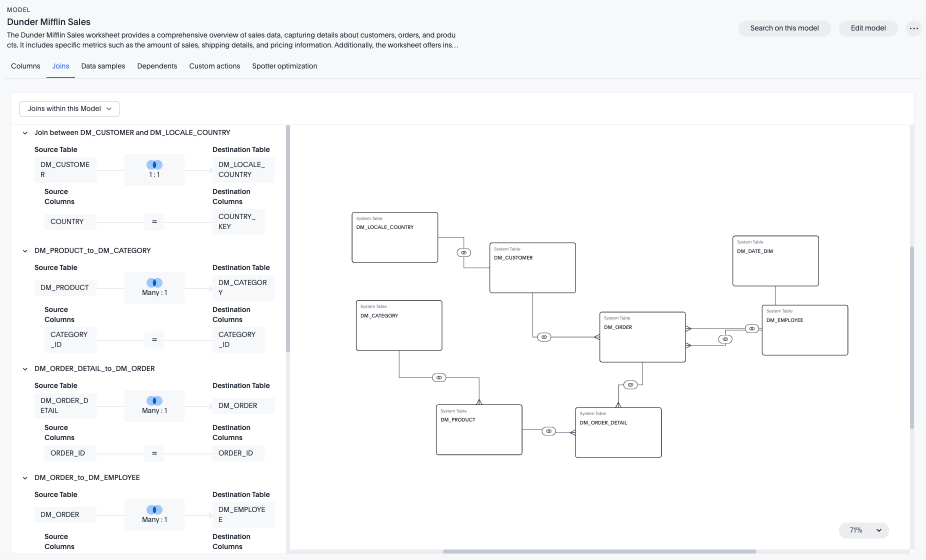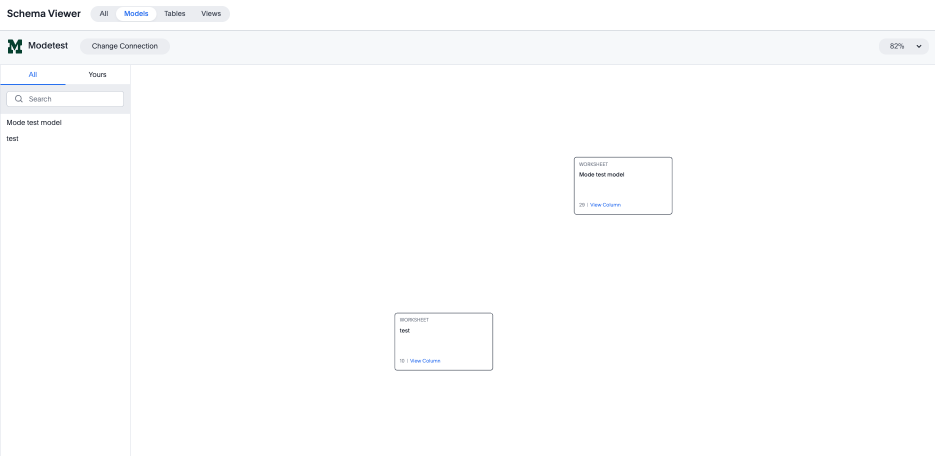How to view a data schema
ThoughtSpot has a Schema Viewer though which you can examine the database schema. It is interactive and configurable, so you can see the level of detail that is relevant to your work.
You use the connection picker drop-down or search to select your connection in the Schema Viewer.
| You can no longer view objects across all connections. You must filter by a specific connection. |
You must have Admin privileges to use the Schema Viewer.
Accessing the Schema Viewer for all objects
-
Select the Data workspace tab.
-
Select Utilities from the side navigation bar.
-
Select Open schema viewer.
-
When the schema appears, you can see that you can control the visible part of the schema.
![Schema viewer. There is a 1 next to the [All | Yours] option. There is a 2 next to the [All types | Models | Tables | Views] option.](_images/schema_viewer.png)
Legend Action 1.
See either All (Default), or Yours.
2.
See either All types (Default), Models, Tables, or Views.
-
The list of tables and Models on the left changes as you select the various filters. The schema view focus changes in tandem.
-
To center the view panel on a specific table, Model, or view, select that object.
You can also drag the objects around in the viewer to position them better.
Accessing Schema Viewer for a single Model, table, or view
You can now see the schema for each object for tables, Models, or views.
-
Select the Data workspace tab.
-
From the list of objects, select one. Here, we selected the Model Dunder Mifflin Sales.
-
At the top of the Model, select the Joins tab.
-
The join information and the schema for the Model appear.

Why use the Schema Viewer
You can use the Schema Viewer to discover the following information:
-
What is the relationship between two tables?
-
What tables make up this Model, and how are they joined?
The schema viewer shows joins between tables, join directionality, and join type.
How the Schema Viewer shows joins
You can use the Schema Viewer to review your schema and ensure that it was modeled using best practices. For example, joins appear in different colors to distinguish their type:
-
Red is used for generic relationships
-
Green is used for primary key/foreign key joins
When viewing a Model, you can also see what joins connect the tables: the inner, left outer, right outer, or full outer joins
A good rule to follow is "Keep it Green". This means that you can get better results from PK/FK joins rather than from using generic relationships. You should only use generic relationships when the tables being joined have a many-to-many rather than a PK/FK structure. If you find tables that have been joined using a generic relationship, but could have used a PK/FK join, you should drop the relationship and create a PK/FK join instead.
Model view
Models are often based on more than one table. The Model schema will show schemas for the tables behind the Model, as well as the joins between tables that were created as a part of the Model.
Select a Model, to see it in the Schema Viewer. If the schema view is not showing the schema behind the Model, click View column.

Related information



